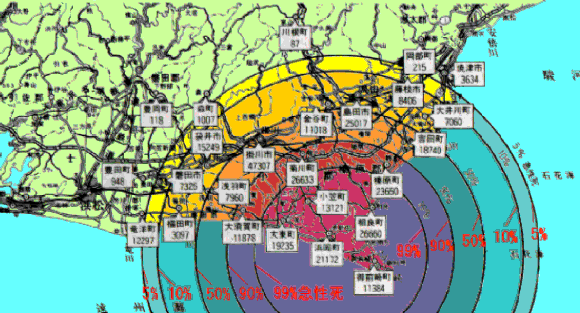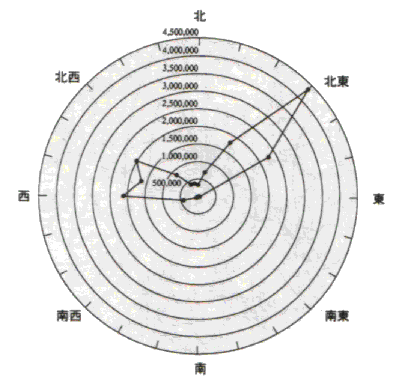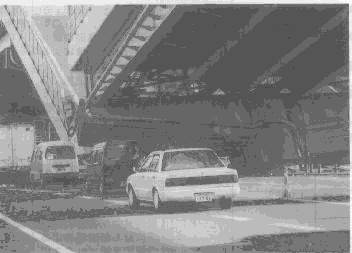Even if nuclear power plants carry out a scram, the accident happens. It is said the operation system of the nuclear power plants
of Hamaoka will stop by the shake of seismic intensity 6 automatically.
But while the land continues shaking who can insert the control rod well?
(Fig. 29)
Even if it is possible to stop it well, you have to continue
turning cooling water. Cooling water leaked in the Tsuruga nuclear power
plant on July 12, 1999. From the small crack of branched piping / 0.2mm
width of 8cm length width 51t water (=1/5 of the whole cooling water)
was lost. The piping explosion accident happened at the No. 1 furnace in November 2001. It was a piping that leads to the cooling device for emergencies. One of two lines of the high-pressure pouring system that pushes the cooling water into a furnace resisting the pressure of the steam in it lost its function. The heavy and steel-made pressure vessel of nuclear reactor, the thick
and long piping, the low-pressure tank of the reactor core cooling (irrigation)
equipment for emergencies, each of them will shake in different way. Very
large pressure should be applied to a joint of these equipments. Especially
No. 1 and 2 furnaces constructed 20 years ago or more. If the big accident occurs in the nuclear power plants of HamaokaImmediately after the operation stop a nuclear reactor has the radioactivity that hits 1 billion to 1 trillion persons' fatal dose if it enters inside the body. Ken Senoo (deceased), who was a assistant of the Kyoto University nuclear reactor experiment place, performed calamity anticipation for every nuclear power plant of Japan in 1995. (At a nuclear power plant disaster, then you? Hubou company) The following is the prediction when the Hamaoka nuclear power plant No. 3 furnace (1,100,000kW of electric outputs) starts a nuclear core meltdown and their container is destroyed. U.S. Atomic Energy Commission calls this type of the accidents "BWR-2 type" and 1/5 of all radioactivities are emitted then. The damage of the accident depends so much on the influence of the wind
and weather conditions, and its weather conditions is assumed cloudy,
2m of wind velocity. In this case, radioactivity spreads at the angle
of about 15 degrees to the lee.
 Fig 30 If radioactivity flows in the direction of land, the number of the acute dead will become a 100,000 people scale in every direction. This is a number of the case that evacuating is impossible.
2. Late-coming obstacle  Fig 31
Fig 31
Our genes get damaged and cancer and some heredity obstacles will also show as the symptoms even with the radiation that does not cause an acute obstacle in dozens of years or several years. Fig. 31 is a prediction of the future cancer death toll according to various direction of the wind at the same accident. When radioactivity spreads in the northeast direction in a metropolitan
area, the future cancer death toll is predicted to be 4,340,000 people.
If it goes in the west direction of Nagoya, it will become 2 million people.
When it spreads in the north direction of Shinshu, since there is little
population, the cancer death toll becomes about 400,000 people. It is
also a number at the time of not emigrating for five years or more.
3. Habitation Impossible Area by Long- Life Radioactivity
Fig. 32 shows the range of the area where the habitation
becomes impossible semi permanently because the ground is polluted by
long-life radioactivity like cesium 137 (half-life 30 years) in a same
accident and the same climate conditions, and when it becomes on the lee.
However, the Soviet Union also changed it into the severe standard in
1991.
Fig. 33 is the actual pollution situation by radioactive cesium by the Soviet Union CHIERUNOVIRI nuclear power plant disaster that occurred in 1986. The position of CHIERUNOVIRI is united with Hamaoka and the Japanese Islands of the same scale are piled up. The area colored purple is the pollution area to remove with more than
15curie (Ci) per square kilometer. The total area of the migration region
specified by three nations; Ukraine, Bell Lucy and Russia is about 10,000
square kilometers, and it is approximately the same area size of united
Shizuoka Prefecture and Yamanashi Prefecture. However, still now, 13 years
after the accident the migration has not completed. All the colored ranges are pollution areas of 1curie per square kilometer or more. In it, the radiation of the strength applicable to a radiation surveillance zone is released in Japan. The area 145,000 square kilometer, it is equivalent to 64% of Honshu in Japan. Cesium 137's contamination to the ground brings about the external contamination
from the gamma ray. When it shifts into crops, it is taken inside of the
body and internal contamination is brought about. 4. Cancer by the radioactivity of comparatively short lifeThe typical short life radioactivity is radioactive iodine. If iodine is taken in inside of the body, it will gather at the thyroid gland and will damage the cell's gene there. Especially the children of a growth phase have active thyroid gland so they get cancer very easily.Radioactivity called iodine 131 decreases at a half rate in eight days. It decreases to 1/100 million within half a year. Therefore, the immediate refuge within half a year influences the future number of development of symptoms. In order to protect from a nuclear power plant earthquake disaster1. Weather conditionsA nuclear power plant calamity depends a lot on the weather
conditions and distance. Accident information may not be transmitted in
case of a big earthquake. 1-1 weather The strength of the radioactivity that rides on a wind and flows
changes with weather.
As the ascending current is strong, the radioactivity
is pressured upwards high up in the sky with large diffusion, and the
radioactive cloud spreads widely thinly. Model "D": Cloudy, almost calm (2m of wind velocity) all
day.
Diffusion is small. Type "F": At the night in winter, very chilly but cleared
up, almost calm (2m of wind velocity)
Since radiative cooling makes the inversion layer, a radioactive cloud does not spread to the sky, but it flows crawling on the ground. It also spreads little in the transverse direction at the surface of the earth, and an angle is 7.5-degree, the width of radioactivity is narrow but reaches to a distant place without thinning. Rainy weather When some radioactive clouds pass by rainy spot, a lot of radioactivity with raindrops will fall. Getting wet to rain brings the worst result. If the radioactive cloud that flowed far away suits rain there, high concentration pollution spot will arise.
Fig. 38 is the typical wind of summer in central Honshu. The wind from Hamaoka is blown to the Ina valley, the Kofu basin, and the Minami-Kantou area. The wind usually blows from the sea to land at daytime in summer and blows from land to the sea at night. 1-3 Wind velocity The relations of the wind velocity and the attainment distance
of radioactivity are mentioned in following explication. The attainment
time of the radioactivity is presumed from wind velocity and the distance.
A radioactive cloud is a collection of the particles of radioactivity.
It isn't black smog shown in a figure, white clouds, either. A radioactive
cloud is not visible.
2. Emergency evacuation  Fig. 39
Fig. 39
At the Tokai earthquake, it is assumed that road is divided, information
is not transmitted, and telephone cannot be used, either. If a radioactive
cloud flows on it, relief will be definitely difficult. We have to give priority to emergency evacuation for the people of the
dangerous zone, where they receive an acute radiation injury if the immediate
refuge does not take. 2-1 Emergency evacuation zone Range of the area where we must evacuate immediately
Using Mr. Ken Senoo's method, the range of the area
where the acute injury contamination of 1Sv or more was caused when
the immediate refuge does not take was calculated. Each case of the
furnace No.1 to 4 has taken out.
Since I think we also have to need simulate about the worst case of the accident by the earthquake, the case of the accidents that happen at all the plants at the same time was calculated, too. The figure shows the emergency evacuation area in the case of
No. 1 (540,000 kw), No. 3 furnace (1,100,000 kw), and all the furnaces
together (3,620,000 kw). The emergency evacuation area in case of the
big accident at No. 1 furnace The emergency evacuation area in case of the
big accident at No. 3 furnace The emergency evacuation area in case of the big accident at all the furnaces
Although it seems that it flows to Minami-Alps also at the time of type "F" in the diagram, as long as watching the situation of usual smog, it is thought that it flows along the bottom of the Ina valley or the Kofu basin. 2-2 The method of emergency evacuation When you are in an emergency evacuation area unfortunately, what
should it carry out? There are some courses exposed you the radiation. Especially the children of a growth phase have the active thyroid gland, and tend to collect iodine. To prevent it, drinking some iodine tablet simultaneously with a contamination front or contamination is efficient not to receive excessive radioactive iodine in the thyroid gland. The iodine tablet should be prepared only for the residents who live
within less than several km areas from the nuclear power plant. However,
in confusion of a big earthquake and emergency evacuation, I doubt whether
it is really distributed. 2-3 The allowance for the emergency evacuation people In the adjoining land region of an emergency evacuation zone,
you have to accept the refuge people. Decontamination work and bathing
should be done immediately. It is necessary to prepare the spare clothing
that is not polluted. Never makes them to wait for a long time. You have to treat to the person who has the acute injury condition. The hospital itself has damaged by the earthquake. You also have to carry out the allowance of the injury people. The persons who were already exposed to a lot of radiation with an acute
condition or not, they all need to take refuge to a distant place preferentially
in order to prevent the further contamination. You have to convey them
somehow to the place that you can get on the train. 3. The refuge area in several daysIt is important not to inhale and not to touch radioactivity if
possible even at the distant place from the emergency evacuation area.
If there is an airtight good building that has not been damaged by the
earthquake, you can take refuge there closing the door and window. However,
the passage of a radioactive cannot be known without the radiation detector. It takes several days to one month for the contamination dose to reach to 1Sv that could cause the acute injury by the contamination of the ground. However, according to Goffman, with the contamination of a little less than 1Sv, the possibility of future cancer death becomes about 40%. Therefore, the pregnant women, infants, and the childen have to take refuge in the area where radioactivity is not descending immediately. The people have to stay at the safe area about for half a year until the influence of radioactive iodine is lost. In case of the Chernobyl nuclear power plant disaster, the children of Kiev got used evacuated 130km over a long period of time. On the other hand, you have to treat those who have escaped from the emergency evacuation area. You also have to offer transportation, in order to carry them to a distance place preferentially. Next, the men and women of the certain age to builds a child after this should take refuge. After the refuge of the persons of the emergency evacuation areas, the rest of the people take refuge. An acute injury can be prevented; if this is completed in several days and they take refuge about for one month.4. Removal area Even after radioactive iodine with a comparatively short
life disappears, contamination by the long life radioactivity remains.
The main one is the cesium 137 and strontium 90 whose half-life is about
30 years. The lee distance from which cancer death becomes more than 20% (contamination
dose of 0.5Sv or more) when you did not emigrate for more than five years
was calculated in each weather conditions and the nuclear power plant.
The area of 20% cancer death possibility by long-life radioactivity was shown in the figure about the case of No. 1 (540,000 kw), No. 3 (1,100,000 kw), and all plants (3,620,000 kw). The sector smeared away is the area of 20% cancer death possibility about the weather type "A", type, "D" and type "F" respectively. The wind blows from south with the velocity of 2m. When wind directions differed, it expressed with the concentric circle how far it would become the area of 20% cancer death possibility. The area where the 20% people die by cancer when the accidents occur at No.1 plant
@ The area where the 20% people die by cancer when the accidents occur at No.3
plant
@
In fact, the wind may change in the middle of radioactivity discharge.
If it rains locally, a high concentration pollution area will be made. @ 5. Rescue operations.
@Many young men rushed for relief in the Hyogo southern part earthquake or the Nakhodka crude-oil outflow. However, it is impossible at a nuclear power plant earthquake disaster. It is impossible to enter in a radioactive contamination area except those who equipped specially for it, and they also need to be ready for remarkable contamination. In the Chernobyl accident, many young soldiers are mobilized and many of them died or got troubles of the sequela. I cannot consider that there are the sufficient equipment and sufficient training and manual in the fire fighting, the police, the Self-Defense Forces in Japan to carry it out. In fact they themselves also have to go away from the stricken area, treating those who have escaped from the stricken area, and sending them out to the distant place. Each of us must consider how it is possible to carry a lot of people to a distant place with the least confusion. The people of an emergency evacuation area will have to take refuge,
rescuing the injured by the earthquake. The people of the adjoining land
region has to evacuate the pregnant women, infants, children and the victims
of the earthquake, they also have to evacuate from the emergency evacuation
area. Acceptance of a lot of nuclear power plant earthquake disaster refugees is required in the area where radioactivity did not reach. I want to young volunteer men to play an active part there. 6. Radiation detector
A radiation detector is required in order to know invisible
passage of the radioactive. There are some kinds according to a use. 2. The type that confirms whether decontamination was completed. (Ordinary carried type) 3. The type that measures the long-term pollution situation of ground. 4. The type that measures radioactivity in food. (1.) and (2.) are needed for an emergency. @ |
|||||||||||||||||||||||||||||||||||||||||||||||||||||||||||||||||||||||||||||||||||||||||||||||||
|
@
Please refer to this URL for details. (Japanese) |